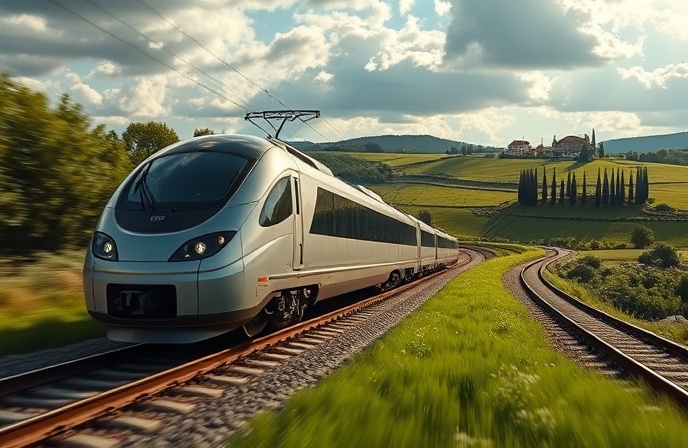Elizabeth Line: Advancements in Rail for Efficiency
Here are a few voiceover-friendly excerpts tailored for railway professionals, based on the provided text:
**Option 1 (Focus on Modernization):**
> The railway industry is rapidly modernizing! From infrastructure upgrades to advanced operational strategies, discover the future of **railway** efficiency.
**Option 2 (Focus on Innovation):**
> Innovative rolling stock and digital technologies are reshaping the **railway** experience, enhancing both efficiency and passenger comfort.
**Option 3 (Focus on the Future):**
> The future of **railways** is here, driven by innovation, sustainability, and operational excellence. Learn how modernizing the railways creates a sustainable transport ecosystem.

Railways: A Deep Dive into Modernization and Efficiency
Introduction:
The railway industry, a cornerstone of global transportation for nearly two centuries, is undergoing a period of unprecedented transformation. This evolution, driven by technological advancements, environmental concerns, and evolving passenger and freight demands, necessitates a critical examination of its current state and future trajectory. This article delves into the key facets of this modernization, exploring the intricate interplay of infrastructure upgrades, innovative rolling stock design, and advanced operational strategies. We will investigate how these elements combine to enhance efficiency, safety, and sustainability within the railway network. From high-speed rail initiatives to the integration of digital technologies, the railway sector is poised for a new era of operational excellence, addressing the challenges of the 21st century while remaining a vital component of a sustainable transport ecosystem. We will explore the multifaceted approach required to ensure that railways remain a competitive and environmentally responsible mode of transport.
Upgrading Infrastructure for Enhanced Capacity
Modernizing railway infrastructure is a complex undertaking, requiring substantial investment and meticulous planning. One crucial aspect involves track upgrades, including the replacement of outdated rails with heavier-duty options capable of handling increased loads and higher speeds. This is frequently complemented by the implementation of advanced signaling systems, such as European Rail Traffic Management System (ERTMS), which enhance safety and allow for more efficient train movements by automatically controlling train speeds and preventing collisions. Furthermore, station improvements, including platform extensions, accessibility upgrades, and the integration of passenger information systems, are vital. The construction of new lines, particularly high-speed rail corridors, is another significant investment. Such projects necessitate sophisticated engineering, including tunneling and bridge construction, to traverse diverse terrains. These infrastructure investments are essential for increasing network capacity, reducing journey times, and enhancing overall operational reliability.
You might be interested in:
Innovative Rolling Stock and its Impact
The design and engineering of rolling stock (trains) are also experiencing rapid advancements. New train designs prioritize passenger comfort, incorporating features such as ergonomic seating, improved climate control, and onboard Wi-Fi. Simultaneously, there is a growing emphasis on energy efficiency and sustainability. This involves the adoption of electric and hybrid propulsion systems, the use of lightweight materials to reduce energy consumption, and the implementation of regenerative braking systems that capture and reuse energy. Furthermore, the integration of digital technologies into trains is transforming operations. Advanced sensors, data analytics, and predictive maintenance systems allow for real-time monitoring of train performance, enabling proactive maintenance and minimizing downtime. The deployment of the *Elizabeth line train* is a prime example of incorporating these technological advancements for passenger comfort and operational efficiency. These innovations are not only improving the passenger experience but also contributing to a more environmentally friendly and cost-effective rail transport system.
Operational Strategies and Efficiency
Optimizing operational strategies is crucial for maximizing the efficiency of railway networks. This includes the implementation of advanced traffic management systems that dynamically route trains, optimize schedules, and respond to disruptions in real-time. Effective fleet management is essential for ensuring that trains are available when and where they are needed. This involves the strategic allocation of rolling stock, the efficient scheduling of maintenance, and the proactive management of any operational delays. Another important area is the adoption of predictive maintenance programs that use data analytics to identify potential equipment failures before they occur. This proactive approach minimizes downtime, reduces maintenance costs, and enhances overall reliability. Collaboration between railway operators, infrastructure managers, and regulatory bodies is also vital for ensuring seamless operations and fostering a culture of continuous improvement.
Conclusion:
In conclusion, the railway industry is undergoing a profound transformation driven by the convergence of technological innovation, environmental considerations, and evolving passenger and freight demands. As demonstrated, infrastructure upgrades, including the implementation of advanced signaling systems, are crucial for increasing network capacity and enhancing safety. The development of innovative rolling stock, emphasizing passenger comfort, energy efficiency, and the integration of digital technologies, is also essential. Simultaneously, optimized operational strategies, encompassing advanced traffic management, efficient fleet management, and predictive maintenance programs, are playing a vital role in maximizing efficiency and reliability.
The long-term success of the railway sector hinges on continued investment in these areas and fostering collaboration between industry stakeholders. By embracing innovation and prioritizing operational excellence, railways can solidify their position as a sustainable, efficient, and competitive mode of transport. As the *Elizabeth line train* demonstrates, modern railways are well-placed to meet the challenges of the future, contributing to a more sustainable and interconnected world. Continued investment and a forward-thinking approach are vital to ensure the railway’s continued relevance and its contribution to a more sustainable transport landscape.





